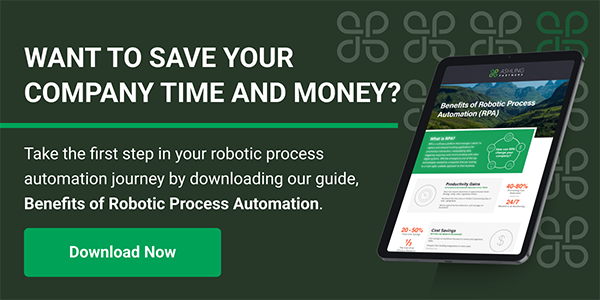Robotic process automation (RPA) has the potential to revolutionize any industry. In applying it to the insurance sector, you can expect to improve processes and productivity.
Because insurance companies were one of the first sectors to adopt RPA, it continues to support the industry’s digital transformation. With it, previously manual processes—such as claims processing—can now lean on automation to reduce workflow time and allow people to do higher-level work.
But how does robotic process automation work, and what are the key ways your insurance business can leverage it?
What Is Robotic Process Automation?
RPA describes “digital workers” that handle repetitive, rules-based tasks—workflows that are the same each time. Some examples include gathering customer information, extracting data from claim forms, and other streamlining of business processes. These manual processes are a significant strain on human labor. They keep people from focusing on tasks that have higher value, and the ability to automate them drives efficiency and productivity.
In the insurance industry, RPA usage is growing. It’s becoming a priority as organizations realize the synergies between what RPA can deliver and the document-heavy insurance processes. In fact, insurance companies can save 34 percent of employees’ time in data processing alone when adopting RPA.
To achieve this, insurance companies must move forward with intelligent automation as the link between disparate systems, including legacy ones. As a result, you can optimize operations, reduce staff costs, and innovate.
How Insurance Organizations Drive Value with Robotic Process Automation
What can RPA do for insurance? Deploying it can evolve so many facets of insurance, especially property and casual (P&C).
UiPath, a leader in RPA solutions, provides a wealth of data regarding RPA and insurance. According to their research, it reduces the time for document management, processing of claims, customer interactions, and more. Leveraging it across the entire insurance ecosystem yields higher output while improving quality.
RPA has become a pivotal technology for the insurance industry. Those using it are honing in on process bottlenecks that require manual input but don’t deviate. In the big picture, RPA can automate these functions:
- Data entry
- Data aggregation
- Copying and pasting data between applications
- Reading and scanning data
- Verification of data like insurance policy dates
- Identifying errors or data mismatches
- Generating alerts for follow-up
- Approvals
10 Ways Insurance Companies Can Implement RPA
With RPA as part of the end-to-end process, insurance companies can remove the tedium of labor-intensive manual tasks and ensure fewer errors.
1. Claims Registration and Processing
Insurers receive a massive volume of claims documents, and processing lots of information from multiple sources is labor-intensive. However, all of this data is necessary to register and process a claim accurately. Most claims systems are rigid in structure, making it harder to introduce automation. They tend to slow things down, which can have negative consequences for insurers when it comes to being responsive to customers.
Integrating RPA into the process makes aggregation of information from all channels easier. It can also extract structured data, track for errors, verify claim details, and more. With the help of this technology, you can eliminate the roadblocks currently holding you back. That’s great news for your employees and customers.
2. Claims Adjudication
Although RPA isn’t powerful enough to make adjudication decisions—that step comes after augmenting RPA with artificial intelligence (AI)—it can streamline the process. By taking over the transactional tasks associated with adjudication, RPA creates a much more efficient process.
3. New Customer Quotes
Every prospective new customer’s first question is about pricing, and they often expect a near-instant reply. Quote generation is dependent upon the information a user enters. RPA can gather information, verify its accuracy, and locate possible errors, and from this, advanced RPA technology can then calculate rates.
4. Underwriting
The foundation of underwriting is risk analysis. To complete this review, you need data from various sources. Assembling this data manually could take days or even weeks to come to a conclusion. That’s not feasible in the modern world.
RPA helps by automating data collection. Furthermore, you can apply it to field populations in internal systems. With this help, accuracy is higher and underwriters can confidently make assessments.
5. Regulatory Compliance
Insurance companies must operate within strict guidelines, documenting adherence with audit trails. Any small error could result in fines for noncompliance. Leaving data compilation and entry in the bucket of manual tasks increases this risk.
RPA is a compliance tool that can:
- Validate customer information
- Generate regulatory reports
- Automate compliance checks
- Trigger processes such as creating required documentation of policy closures
6. Policy Cancellations
Customers submit numerous cancellation requests every day, and moving through all of these manually would cause a considerable backlog. If not processed promptly, they can lead to complaints. Policy cancellation is a series of transactional processes, including verifying the inception date, determining the expiration date to evaluate any refunds due, and a review of policy terms. RPA gathers data and validates it to make this process rapid.
7. Integrations
Legacy systems are still part of the insurance technology infrastructure. That can be a challenge when they can’t share data with newer solutions. RPA can be a bridge to improve interoperability, taking structured data from System A and delivering it to System B.
8. Customer Support
Another way to use RPA is with RPA bots, or chatbots, to engage with customers who have simple questions such as “How do I file a claim?” or “Where do I locate my policy number?” Answering these questions doesn’t require a contact center intervention. Bots can deliver the information, and your customers have a convenient, positive experience.
9. Financial Reconciliations
RPA bots excel at pressing buttons, performing keystrokes, and copy-pasting. That comes in handy for finance and accounting activities. For instance, RPA bots are ideal for handling daily bank reconciliation tasks. It’s much faster and often more accurate than any manual approach.
10. Policy Administration and General Servicing
Policy administration is the umbrella over all other functions, including quotes, rates, underwriting, and so on. Systems exist that manage this group of functions, but they’re often of the legacy variety, making them hard to scale. These systems are massive in nature, often referred to as clunky, hard to navigate, and not user-friendly. In turn, these issues create a poor user experience, which derails productivity and consistency.
Adding RPA to the workflows empowers you to enjoy smoother operations. By automating the administrative and transactional areas across the back-office ecosystem. RPA removes those tedious tasks from employee plates. Use RPA to update policies when customers have changes, automate renewal reminders, and fill in forms within management platforms.
All these use cases for RPA in insurance are just the start. You can move to the next level of process automation when involving AI. However, it’s critical to deploy RPA, understand its effectiveness, make adjustments, and measure its impact first.
Explore More Benefits of Robotic Process Automation
The urgency to implement RPA is critical for insurance entities. Demand isn’t waning for these services, and organizations need to improve processes in the long term to operate optimally.
By investing in RPA, you can see substantial benefits beyond reduced costs and efficiency. It can enhance customer interactions and foster more satisfaction for employees. Learn more about RPA benefits by downloading “Benefits of Robotic Process Automation.”



